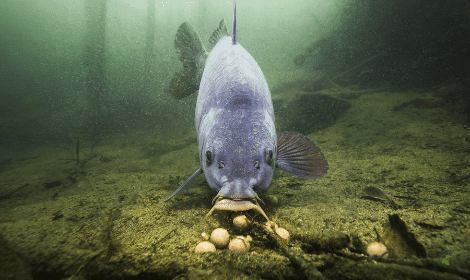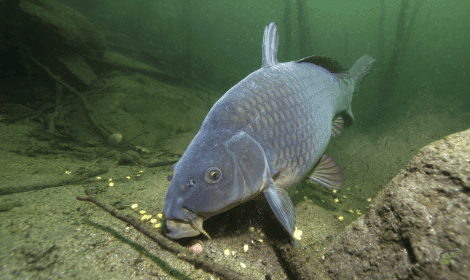
Today we are going to deviate slightly from the information posts surrounding carp fishing and focus more on carp behaviours.
By taking a step away from carp fishing techniques to read more about their behaviours and how they feed, swim and act under the water surface you might actually learn some knowledge that can be used for your fishing.
Today we are going to take a look at how carp feed to answer the question of “are carp bottom feeders?”.
Surprisingly this is a question that is asked a lot by beginner carp anglers but by knowing the answer you can start to understand why fishing techniques such as method feeders provide a great opportunity for catching more carp.
To help explain fully if carp are bottom feeders or not I’ll discuss the following topics to give you as much information as possible;
- What are bottom feeders?
- Are Carp bottom feeders?
- Methods for fishing for carp on the bottom?
- How else do Carp Feed?
What are bottom feeders?
So, as a starting point I’ll cover exactly what a bottom feeder is and what characteristics a fish must have to be classed as one. According the google dictionary a bottom feeder is;
“any marine creature that lives on the seabed and feeds by scavenging”
Sound like carp? Not too far away I’d say.
Although this definition seems to focus on sea dwelling creatures their freshwater equivalents can also be classed as bottom feeders by living close to lake beds and scavenging for food.
As bottom feeders spend a lot of time on the lake or sea bed they have flat undersides or “flat ventral regions” to easily rest their bodies on the bottom when scavenging for food.
Another common feature of bottom feeders is the “inferior mouth“.
An inferior mouth is basically just another way of saying the fish has a down turned mouth that will point towards the lake bed. This makes sense for bottom feeding fish as they can swim near horizontal and sift through the silt below.
Are Carp bottom feeders?

Going by this definition it would definitely seem that;
Yes carp fit within the bottom feeding category but let’s take a closer look into why this is the case and why some people might not believe they are purely bottom feeders
As a lot of you will already know, carp spend a lot of time feeding on the bottom and scavenging for natural food such as insects, crustaceans, worms, plant matter and basically anything that looks edible enough.
As far as having a “flat ventral region though” this might not be 100% true for carp. This mainly refers to fish such as various rays and even hammerhead sharks that are extremely flat on the bottom to consistently move across the flat bottom.
For carp this is not really the case but does make them a non bottom feeder? Nope not at all.
They also have a clear inferior down turned mouth that is perfect for sifting through the silt on the bottom of the lake and inhaling anything edible that is found.
Although carp are well-known as bottom feeders this is not the only place that they feeder and they probably only feed on the bottom for 40-50% of the time.
Carp feed in nearly all sections of the water column and are even known to feed directly on the surface.
It is no wonder that some people would not class carp as bottom feeders when in fact they definitely are.
In the video below you can get an underwater view of how carp react and feed on your bottom baits;

Methods for Fishing for Carp on the Bottom
Now that you know that carp are bottom feeders and spend a lot of their time scavenging the bottom it must now be clear that so many of the common method for carp fishing relies on getting your bait to the bottom.
Methods such as the;
- Method feeder
- Cage feeder
- Maggot feeder
- Even float fishing
All rely heavily on getting your feeder bait and your hook bait to the bottom of the lake to find the feeding carp. Don’t get me wrong not all float fishing for carp will mean your bait should be resting on the bottom but this is quite often the case.
These types of feeders and any other feeders actually are all used for getting your bait to the bottom. They mainly all work in the same way.
By filling or moulding loose feed around the feeder such as ground bait, micro pellets or maggots for a maggot feeder this bait is sunk to the lake bed where it begins to break up or disperse into the water to attract in the scavenging carp.
Your hook length will be attached to the end of this feeder as a prominent piece of bait that the carp will pick up when rooting through the bundle of loose feed.
There is many successful methods for fishing the bottom for carp but these are a few main methods that you should be trying.
How else do Carp Feed?
Although carp are classified as bottom feeders you won’t always find them scavenging on the bottom so I’ll give you a bit of information or where else carp tend to feed and what conditions you will most likely find them feeding in each area.
Carp generally feed throughout the water column from evidently the bottom, mid-water and even the surface in certain conditions.
Generally where carp will be feeding will depend on the type of year and the weather conditions.
In the summer months on high pressure days when the sun is warming the water the carp will be more active and can quite often be seen cruising the surface where they will pick up any food they come across floating on the top.
On days like this fishing the surface with bread crusts or float fishing with pellets or boilies near the surface can be extremely lucrative.
On the other hand, in winter months when the water is colder carp will quite often be found near the bottom where they move around lethargically.
On days like this you will definitely be better fishing bottom baits but it’s always going to be more challenging fishing the winter months.
Fishing in the rain can also have a direct effect on where carp will be feeding.
When carp are moving up and down the water column they will generally pick up anything edible that they come across so on some days float fishing to depths can also pick up some decent fish.
If you want some more information on how carp feed take a read at this post.
That’s All!
Now that you know that carp are definitely classed as bottom feeders and why you use bottom fishing methods to catch them you can get yourself on the bank and start to learn these techniques.
Now that you know that carp are more often than not going to be feeding on the bottom you can fish on the bottom with more confidence knowing that they must be somewhere down their and not all swimming around in various upper sections of the water.
I hope you’ve found this content useful and can take some new knowledge away. If you have any questions or anything to ask then please leave a comment below and I will get back to you ASAP!

